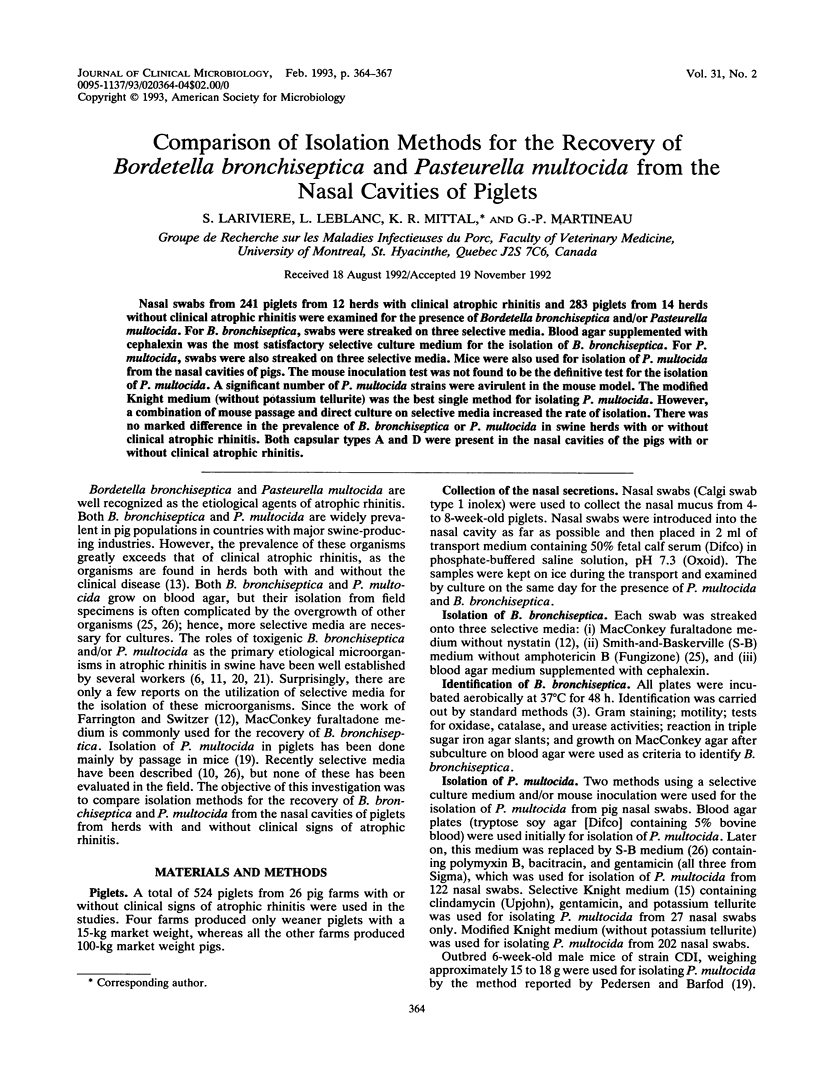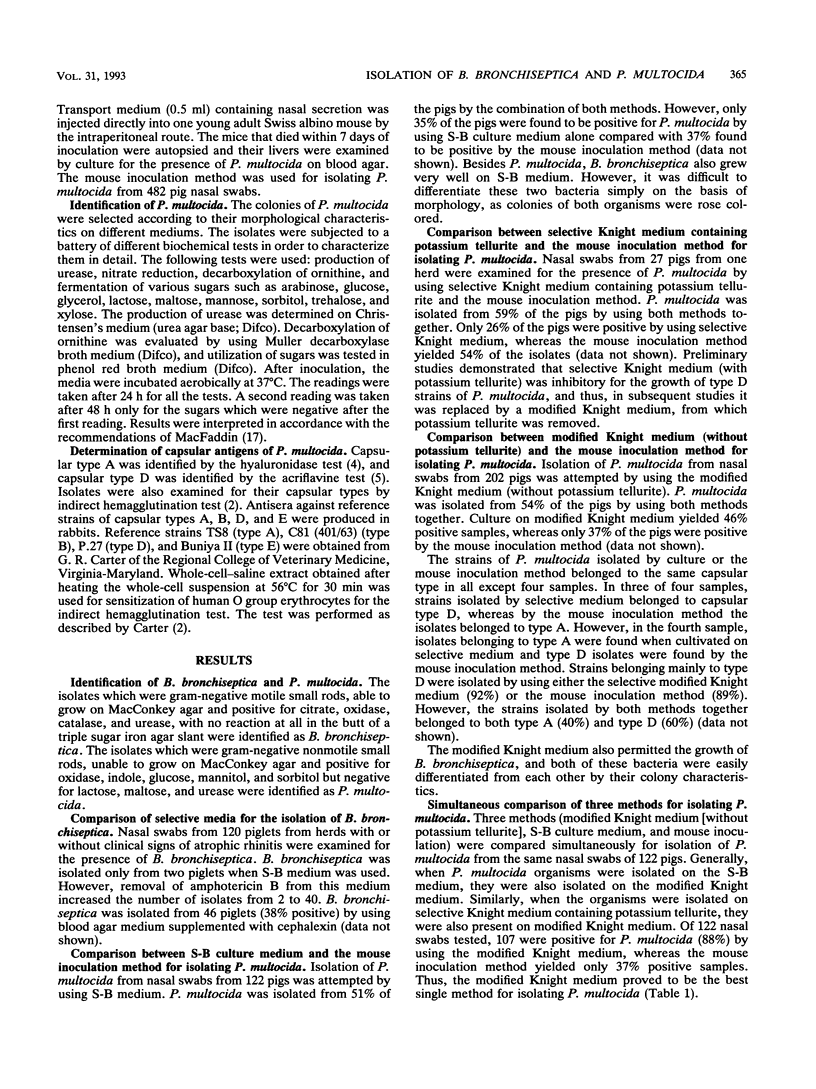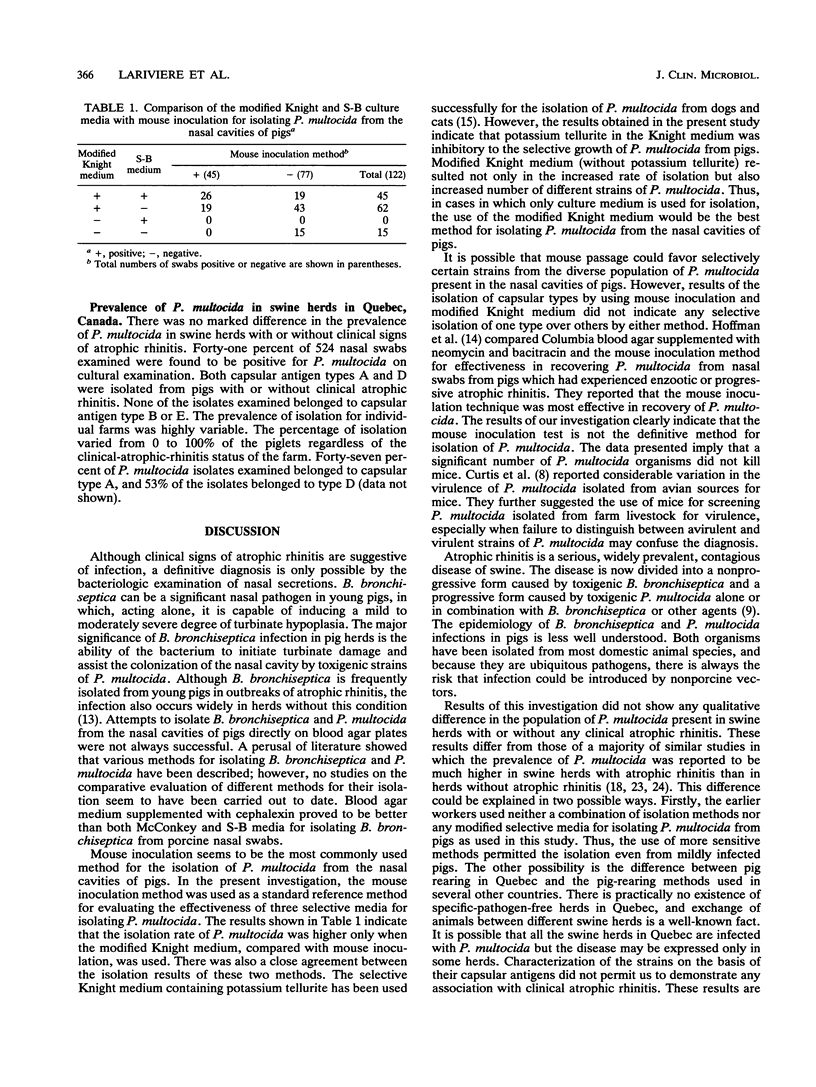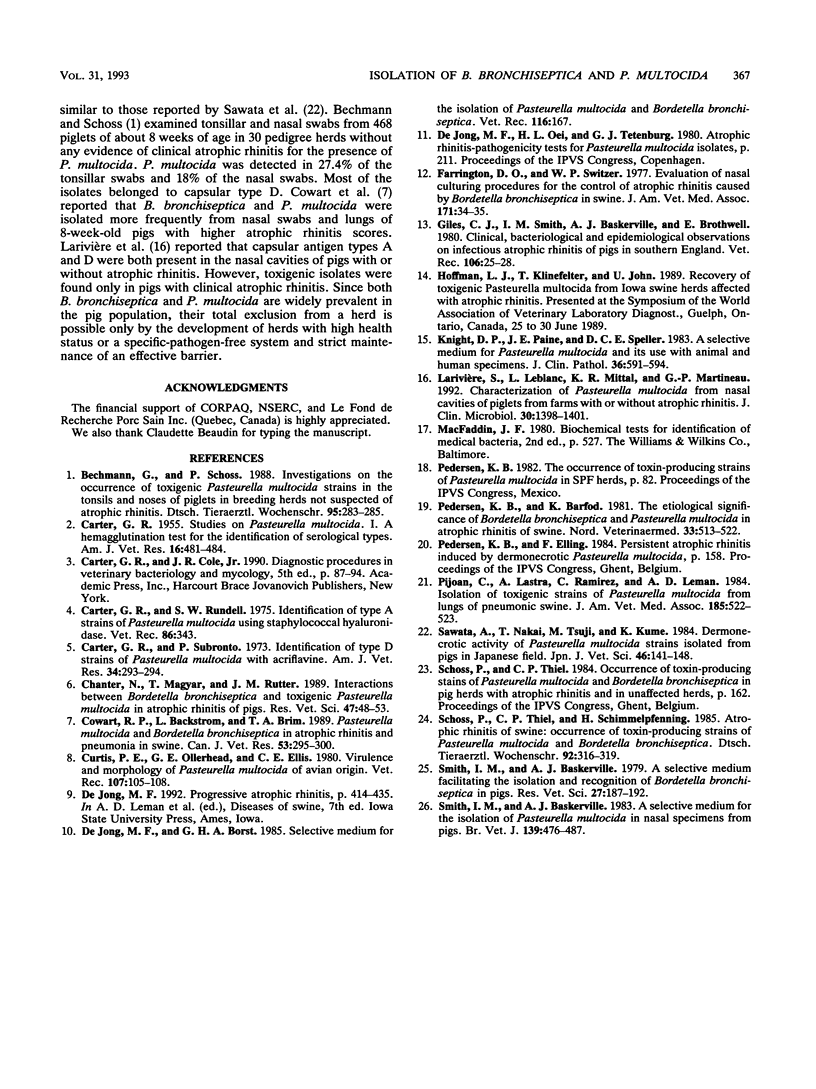Abstract
Nasal swabs from 241 piglets from 12 herds with clinical atrophic rhinitis and 283 piglets from 14 herds without clinical atrophic rhinitis were examined for the presence of Bordetella bronchiseptica and/or Pasteurella multocida. For B. bronchiseptica, swabs were streaked on three selective media. Blood agar supplemented with cephalexin was the most satisfactory selective culture medium for the isolation of B. bronchiseptica. For P. multocida, swabs were also streaked on three selective media. Mice were also used for isolation of P. multocida from the nasal cavities of pigs. The mouse inoculation test was not found to be the definitive test for the isolation of P. multocida. A significant number of P. multocida strains were avirulent in the mouse model. The modified Knight medium (without potassium tellurite) was the best single method for isolating P. multocida. However, a combination of mouse passage and direct culture on selective media increased the rate of isolation. There was no marked difference in the prevalence of B. bronchiseptica or P. multocida in swine herds with or without clinical atrophic rhinitis. Both capsular types A and D were present in the nasal cavities of the pigs with or without clinical atrophic rhinitis.
Full text
PDF



Selected References
These references are in PubMed. This may not be the complete list of references from this article.
- Bechmann G., Schöss P. Untersuchungen über das Vorkommen toxinbildender Pasteurella-multocida-Stäme in Tonsillen und Nasen von Ferkeln aus Rhinitis-atrophicans-unverdächtigen Zuchtbeständen. Dtsch Tierarztl Wochenschr. 1988 Jul-Aug;95(7):283–285. [PubMed] [Google Scholar]
- CARTER G. R. Studies on Pasteurella multocida. I. A hemagglutination test for the identification of serological types. Am J Vet Res. 1955 Jul;16(60):481–484. [PubMed] [Google Scholar]
- Carter G. R., Rundell S. W. Identification of type A strains of P multocida using staphylococcal hyaluronidase. Vet Rec. 1975 Apr 12;96(15):343–343. doi: 10.1136/vr.96.15.343. [DOI] [PubMed] [Google Scholar]
- Carter G. R., Subronto P. Identification of type D strains of Pasteurella multocida with acriflavine. Am J Vet Res. 1973 Feb;34(2):293–294. [PubMed] [Google Scholar]
- Chanter N., Magyar T., Rutter J. M. Interactions between Bordetella bronchiseptica and toxigenic Pasteurella multocida in atrophic rhinitis of pigs. Res Vet Sci. 1989 Jul;47(1):48–53. [PubMed] [Google Scholar]
- Cowart R. P., Bäckström L., Brim T. A. Pasteurella multocida and Bordetella bronchiseptica in atrophic rhinitis and pneumonia in swine. Can J Vet Res. 1989 Jul;53(3):295–300. [PMC free article] [PubMed] [Google Scholar]
- Curtis P. E., Ollerhead G. E., Ellis C. E. Virulence and morphology of Pasteurella multocida of avian origin. Vet Rec. 1980 Aug 2;107(5):105–108. doi: 10.1136/vr.107.5.105. [DOI] [PubMed] [Google Scholar]
- Farrington D. O., Switzer W. P. Evaluation of nasal culturing procedures for the control of atrophic rhinitis caused by Bordetella bronchiseptica in swine. J Am Vet Med Assoc. 1977 Jan 1;170(1):34–36. [PubMed] [Google Scholar]
- Giles C. J., Smith I. M., Baskerville A. J., Brothwell E. Clinical bacteriological and epidemiological observations on infectious atrophic rhinitis of pigs in southern England. Vet Rec. 1980 Jan 12;106(2):25–28. doi: 10.1136/vr.106.2.25. [DOI] [PubMed] [Google Scholar]
- Knight D. P., Paine J. E., Speller D. C. A selective medium for Pasteurella multocida and its use with animal and human specimens. J Clin Pathol. 1983 May;36(5):591–594. doi: 10.1136/jcp.36.5.591. [DOI] [PMC free article] [PubMed] [Google Scholar]
- Lariviere S., Leblanc L., Mittal K. R., Martineau G. P. Characterization of Pasteurella multocida from nasal cavities of piglets from farms with or without atrophic rhinitis. J Clin Microbiol. 1992 Jun;30(6):1398–1401. doi: 10.1128/jcm.30.6.1398-1401.1992. [DOI] [PMC free article] [PubMed] [Google Scholar]
- Pedersen K. B., Barfod K. The aetiological significance of Bordetella bronchiseptica and Pasteurella multocida in atrophic rhinitis of swine. Nord Vet Med. 1981 Dec;33(12):513–522. [PubMed] [Google Scholar]
- Pijoan C., Lastra A., Ramirez C., Leman A. D. Isolation of toxigenic strains of Pasteurella multocida from lungs of pneumonic swine. J Am Vet Med Assoc. 1984 Sep 1;185(5):522–523. [PubMed] [Google Scholar]
- Sawata A., Nakai T., Tuji M., Kume K. Dermonecrotic activity of Pasteurella multocida strains isolated from pigs in Japanese field. Nihon Juigaku Zasshi. 1984 Apr;46(2):141–148. doi: 10.1292/jvms1939.46.141. [DOI] [PubMed] [Google Scholar]
- Schöss P., Thiel C. P., Schimmelpfennig H. Rhinitis atrophicans des Schweines: Untersuchungen über das Vorkommen toxinbildender Stämme von Pasteurella multocida und Bordetella bronchiseptica. Dtsch Tierarztl Wochenschr. 1985 Sep 6;92(9):316–319. [PubMed] [Google Scholar]
- Smith I. M., Baskerville A. J. A selective medium facilitating the isolation and recognition of Bordetella bronchiseptica in pigs. Res Vet Sci. 1979 Sep;27(2):187–192. [PubMed] [Google Scholar]
- Smith I. M., Baskerville A. J. A selective medium for the isolation of P. multocida in nasal specimens from pigs. Br Vet J. 1983 Nov-Dec;139(6):476–486. doi: 10.1016/s0007-1935(17)30332-9. [DOI] [PubMed] [Google Scholar]
- de Jong M. F., Borst G. H. Selective medium for the isolation of P multocida and B bronchiseptica. Vet Rec. 1985 Feb 9;116(6):167–167. doi: 10.1136/vr.116.6.167-c. [DOI] [PubMed] [Google Scholar]


